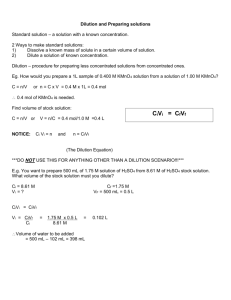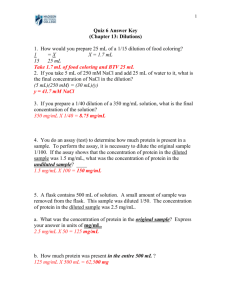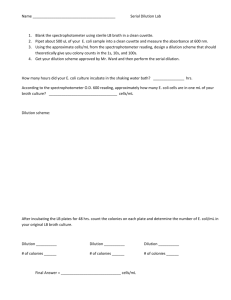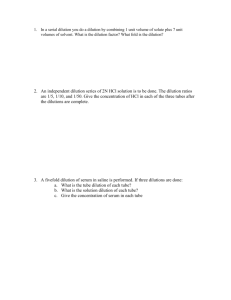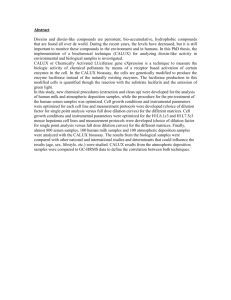Calcium Carbonate in Eggshell
advertisement
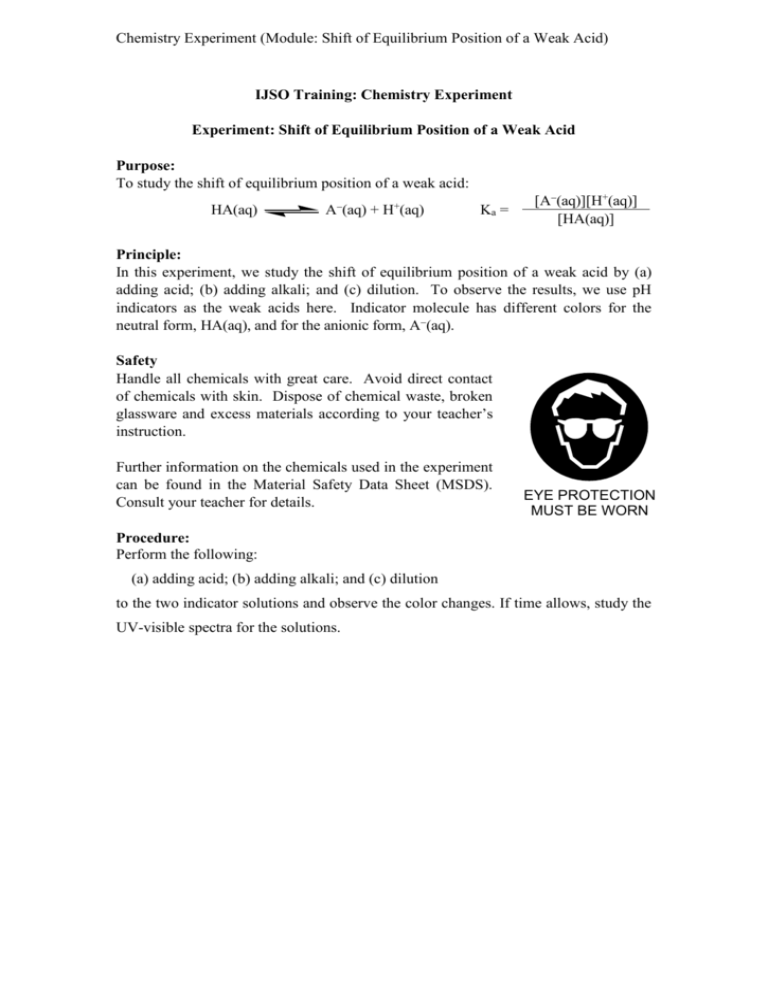
Chemistry Experiment (Module: Shift of Equilibrium Position of a Weak Acid) IJSO Training: Chemistry Experiment Experiment: Shift of Equilibrium Position of a Weak Acid Purpose: To study the shift of equilibrium position of a weak acid: HA(aq) A(aq) + H+(aq) Ka = [A(aq)][H+(aq)] [HA(aq)] Principle: In this experiment, we study the shift of equilibrium position of a weak acid by (a) adding acid; (b) adding alkali; and (c) dilution. To observe the results, we use pH indicators as the weak acids here. Indicator molecule has different colors for the neutral form, HA(aq), and for the anionic form, A(aq). Safety Handle all chemicals with great care. Avoid direct contact of chemicals with skin. Dispose of chemical waste, broken glassware and excess materials according to your teacher’s instruction. Further information on the chemicals used in the experiment can be found in the Material Safety Data Sheet (MSDS). Consult your teacher for details. EYE PROTECTION MUST BE WORN Procedure: Perform the following: (a) adding acid; (b) adding alkali; and (c) dilution to the two indicator solutions and observe the color changes. If time allows, study the UV-visible spectra for the solutions. Chemistry Experiment (Module: Shift of Equilibrium Position of a Weak Acid) Results: Indicator #1: bromocresol green (Ka ~ 1.9 x 105 M) Color: Acidic (small pH) Slightly acidic (dissolved in water) Adding acid/alkali Alkaline (large pH) Dilution: ----------------------- ----------------------- Further dilution: ----------------------- ----------------------- Indicator #2: methyl orange (Ka ~ 3.5 x 104 M) Color: Acidic (small pH) Slightly acidic (dissolved in water) Adding acid/alkali Alkaline (large pH) Dilution: ----------------------- ----------------------- Further dilution: ----------------------- ----------------------- If time allows, obtain the UV-visible spectra for the solutions. Sketch the spectra below. Write the peak positions and absorbances. Indicator #1: bromocresol green (Ka ~ 1.9 x 105 M) Acidic (small pH) Alkaline (large pH) Chemistry Experiment (Module: Shift of Equilibrium Position of a Weak Acid) Slightly acidic (dissolved in water) Dilution: Further dilution: Indicator #2: Methyl Orange (Ka ~ 3.5 x 104 M) Acidic (small pH) Alkaline (large pH) Slightly acidic (dissolved in water) Dilution: Further dilution: Chemistry Experiment (Module: Shift of Equilibrium Position of a Weak Acid) Discussions: (1) Adding acid to a weak acid solution causes its equilibrium position to shift to the left/right and adding alkali causes the position to shift to the left/right. (2) Dilution of the solution of Indicator #1 results in color change. But dilution of the solution of Indicator #2 does not result in color change. (Color is lighter in both cases because of dilution.) (a) Dilution causes equilibrium position to shift to the right. It can be rationalized in the following way. Suppose the solution is diluted by a factor of 2. Immediately after dilution, [HA(aq)], [A(aq)], and [H+(aq)] are halved. The fraction, [A(aq)][H+(aq)]/[HA(aq)] becomes smaller. The equilibrium position will shifts in such a way to make this fraction equal to Ka again, i.e., to make this fraction increase. Therefore, the product-side is favored to increase both [A(aq)] and [H+(aq)]; and to decrease [HA(aq)]. In brief, the lower the concentration, the more favorable the product-side is. (b) Mathematical treatment: HA(aq) Initial: x0 Final: (x0 x) A(aq) 0 x Ka = + H+(aq) 0 x [A(aq)][H+(aq)] [HA(aq)] = x2 (x0 x) We have the quadratic equation: x2 + Ka x Ka x0 = 0. The (positive) solution is: x = Ka + (Ka2 + 4 Ka x0) 2 This formula allows one to calculate [HA(aq)], [A(aq)], and [H+(aq)]. For example, for a 0.01 M acetic acid solution (Ka for acetic acid = 1.8 x 105 M), [H+(aq)] = 4.2 x 104 M, corresponding to pH = _____. (c) Using the above formula, we can study how [HA(aq)] and [A(aq)] changes upon dilution for the 3 cases: (i) x0 Ka; (ii) x0 ~ Ka; and (iii) x0 Ka with some numerical values. (i) x0 Ka x0 (M) 1 x 102 5 x 103 2 x 103 Ka (M) 1 x 106 [A(aq)]/x0 0.01 0.01 0.02 [HA(aq)]/x0 Conclusion 0.99 Mostly HA(aq) 0.99 in solution whatever x0 is 0.98 Chemistry Experiment (Module: Shift of Equilibrium Position of a Weak Acid) 1 x 104 (ii) x0 ~ Ka 5 x 105 2 x 105 1 x 105 (iii) x0 Ka 1 x 105 5 x 106 2 x 106 5x 104 0.36 0.64 0.46 0.54 0.73 0.27 0.98 0.99 1.00 0.02 0.01 0.00 x0 for bromocresol green: ~ 5 x 105 M x0 for methyl orange: ~ 1 x 105 M Relative amounts of HA(aq) and A(aq) change upon dilution Mostly A(aq) in solution whatever x0 is (Ka ~ 1.9 x 105 M) (Ka ~ 3.5 x 104 M) Therefore, we observe color change upon dilution for bromocresol green [similar to Case (ii)] but not for methyl orange [similar to Case (iii)]. Exercise: (if you are interested in algebra) (a) Determine x0 (in terms of Ka) if [HA(aq)] = [A(aq)]. (b) Show the following: (i) if x0 Ka, then [A(aq)] (Ka x0)1/2 and [HA(aq)] x0. (ii) if x0 Ka, then [A(aq)] x0 and [HA(aq)] (x02 / Ka).


